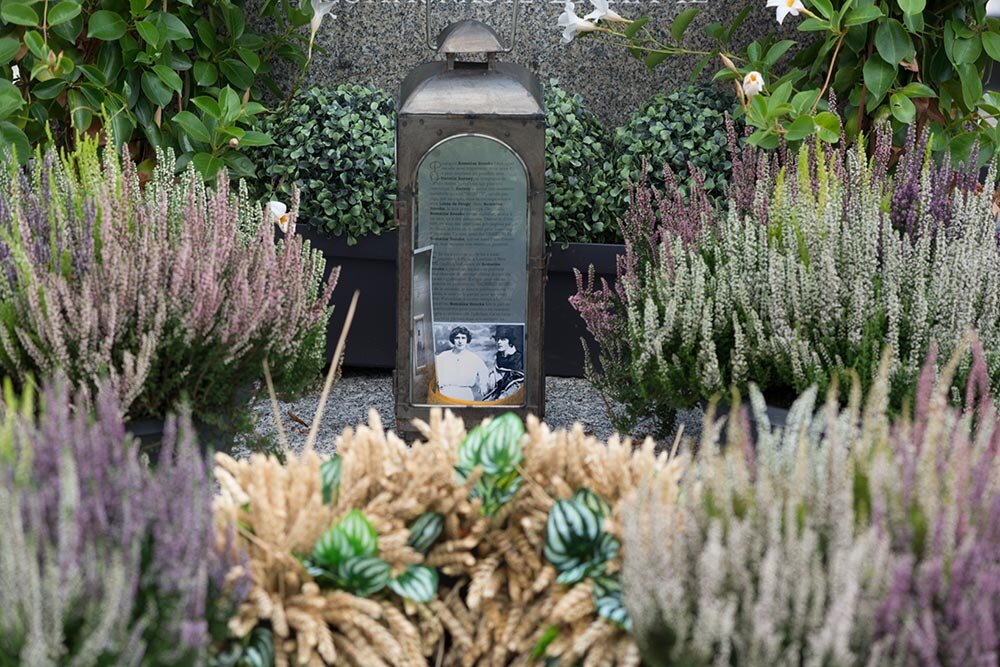September 15, 2021
Pourquoi Romaine Brooks (1874-1970) est-elle aussi importante pour nous ? On peut esquisser un parallèle avec Natalie Barney, sa compagne de vie (du moins, jusqu’à un âge plus que canonique[1] !). Barney a donné une existence matérielle au mot “lesbienne“, qu’elle partage, par exemple, dans sa correspondance avec Liane de Pougy. Avec Romaine Brooks, le mot prend corps. Ou plutôt, Romaine Brooks donne visibilité, moins à un mot, qu’à des personnes. Disons-le d’emblée, ce sont des personnes privilégiées par la classe, la fortune, le statut pour beaucoup d’expatriée. Ce sont aussi des lesbiennes. Et Romaine Brooks, qui est aussi l’une d’entre elles, leur façonne une existence picturale.
Elle les a peintes et elle les a aussi exposées, à Paris, à Londres, à New York (1925). L’insistance de Romaine Brooks à présenter les mêmes portraits dans chacune de ses expositions durant dix ans est significative. Il s’agit pour elle de produire en peinture un “panthéon“ lesbien- et de le montrer, le rendre publiquement visible, et non de le garder pour un usage privé. S’attachant à contre-temps à la forme figurative, Romaine Brooks fait le pari de l’anachronisme pour peindre « en nuances de gris »—comme elle l’affichait sur sa carte de visite et partout dans son atelier— un monde “moderne“, où chacune peut à la fois s’identifier à son genre et affirmer crânement sa distinction aux yeux des autres.
A commencer par Romaine Brooks elle-même.
Chapeau claque noir vissé sur le crâne et yeux cernés de “femme damnée“ – ou de peintre maudit ?- elle s’est représentée, en 1923. Dans son Autoportrait, son habit noir, qui laisse entrevoir une chemise blanche entrouverte, est orné au col de la barrette cramoisie d'une légion d'honneur. Elle domine un paysage urbain défait derrière elle, comme elle maîtrise sa représentation : habit, gants, chemise empruntent au flâneur masculin, le vermillon aux lèvres rappelant le ruban rouge jouent avec d’autres codes où l’héroïsme n’est pas forcément l’apanage du patriarcat. C’est tout un art de composition que nécessitent ces portraits pour représenter, par petites touches, celles qui veulent se libérer des conventions hétéronormées de la féminité. Ainsi Peter, une jeune fille anglaise (1923-24) – notez le titre- où l’artiste figure une autre peintre, Hannah Gluckstein, dit Gluck, déployant toute la grâce séductrice de sa non-binarité. Gluck rejetait tous les genres de pronoms. Un·e dandy n’a-t-iel pas “obligation d’incertitude“ comme le titrait l’ouvrage de la philosophe Françoise Coblence ? Ou bien Una, Lady Troubridge, (1924) avec sa coupe au bol, ses pantalons rayés, son col cassé et sa cravate, son monocle, sa montre à gousset et son couple de chiens dashshunds, donnés d’ailleurs par son amante l’écrivaine Radclyffe Hall. La construction d’une culture aristocratique lesbienne s’effectue sous l’œil de ses paires, au moment où, en Angleterre par exemple, elle se trouve de plus en plus scrutée par la loi (en 1928, la publication en anglais du Puits de Solitude de Radlyffe Hall déclenche un procès pour obscénité).
Les portraits de Romaine Brooks emplissent le cadre qui leur est imparti de façon pleine et entière. Leur définition ne dépend ni d’un lien à un homme (mari, père, enfant, peintre), ni à une des fonctions (épouse, mère, amoureuse, prostituée, domestique, copiste ou amateure) traditionnellement dévolue aux « femmes ». L’artiste puise dans le fonds pictural d’une tradition bourgeoise, sombre et décadente (et souvent misogyne) pour en revêtir ses lesbiennes, et cela sans jamais les réduire à un seul type, un seul genre, un seul “style“ de visibilité. A chacune le sien : Elisabeth de Gramont, Duchesse de Clermont-Tonnerre (1924) – c’est la troisième du trouple formé avec Brooks et Barney ; la Baronne Emile d'Erlanger et son lynx ; Renatta Borgatti au Piano, ca 1920 ; l'américaine Muriel Draper 1938. Toutes portent les signes d'une apparence qu'elles ont, sinon choisie, du moins négociée avec l’artiste. C’est cela, sans doute, qu’on lit dans le regard fixe, nappé d’ombre, de Natalie Barney, ‘L’Amazone’ (1920) le tableau, qui, avec son cadre couleur argent, trône au musée Carnavalet, depuis la réouverture de celui-ci en début d’été 2021. Certes, celle-ci se présente flanquée du petit bronze d’un cheval en pleine course, allusion à son surnom d’amazone donné par Rémy de Gourmont, qui presse les feuilles volantes de l’écrivaine… Mais ce n’est pas cela qui retient. Nous, qui la regardons, savons qu’il y a eu un échange préalable, un “lesbian gaze“, partagé avant nous. Et qui nous attend.
Notre culture lesbienne nous attend.
————————
[1] La dernière année de sa vie, Romaine Brooks interrompit toute relation avec Natalie Barney.
Elisabeth Lebovici
Author, Ce que le sida m’a fait : art et activisme à la fin du XXe siècle
If You Were my Mothers
If you were my mothers
would you have made time
for stories and scrapbooks?
Maybe not until the day came
for prodigal daughters
to help clear out the attic
so Granny could sell the farm.
If you were my lesbian grandmothers
would you have saved everything
in that attic? Old trunks full of
letters and photographs,
bits of ribbon, passports and tickets,
Bates fading from the musty hat boxes,
Weird cravats and capes and rings,
shoe trees stamped with John Lobb,
copies of copies of
Smithsonian manifests?
If you were my gay great grannies
how could you have known
what a ruckus you started that afternoon?
It was September in Paris during the war.
Tea with the Senator’s daughter.
A very rich friend of your mother.
Presenting in her Georgia drawl
the slender shape of your immediate future.
If you were my daughters
I’d have drifted with you to the door
wanting to stay that moment on the brink
of the portrait you’d paint together
the book you’d write together
the house you’d build together
the war you’d live through together.
Vaguely floating the absurd idea:
“Will I see you, then,
for supper after the play?”
One of you would’ve been
politely silent, the other defiant,
blue eyes already through the door
where the car waits purring.
Suzanne Stroh
Translator, Un soir chez l’Amazone by Francesco Rapazzini
Narrator, A Night at the Amazon's by Francesco Rapazzini (audiobook)
Romaine Brooks (1874-1970): why is she so important to us? There’s the similarity with Natalie Barney, her life partner (for at least enough years to qualify!).[1] Barney gave concrete meaning to the word “lesbian,” which she declared, for example, in her letters with Liane de Pougy. With Romaine Brooks the word took form. Or, rather, Romaine Brooks gives it visibility, not so much to the word as to the people who embody it. Make no mistake, we’re talking about people who are privileged by class, wealth, and, for many, expatriate status. They also happen to be lesbians. And Romaine Brooks, who was of that very world, made a place for them in art.
She painted them and she exhibited them, in Paris, in London, and in New York (1925). Her insistence on including the same portraits in each of her shows over ten years is significant. She was painting a lesbian “pantheon”—and displaying it, making it visible to all, not reserving it for private viewing. Going against the grain as a figurative painter, Romaine Brooks gambled on anachronism by painting “modern” life in “grey scale”—as she declared on her calling card and everywhere in her studio. It’s a world where everyone was identified by gender and proudly affirmed her difference in the eyes of others.
Starting with Romaine Brooks herself.
Black top hat screwed to her head with the sunken eyes of “La Femme Damnée”—or those of an accursed painter?[2] This is how she depicts herself in 1923. In her Self Portrait she pins the insignia of the Legion of Honor to the man’s hunt coat she wears over a white shirt open at the throat. She dominates an urban landscape in ruins behind her, just as she retains full control over her appearance: the riding coat, the gloves, the rakish shirt, the scarlet lips recalling the red ribbon playing with other visual codes for contexts where heroism is not a male prerogative. It took a whole new form of composition to represent, with subtle touches, women who want freedom from the heteronormative conventions of femininity. And so we have Peter, A Young English Girl (1923-24)—note the title—where the artist painted another painter, Hannah Gluckstein, known as Gluck, evoking all the seductive elegance of her non-binarity. Gluck rejected all the pronouns. Didn’t a female dandy have the “duty of uncertainty” called for by Françoise Coblence in the title of her 1988 book of philosophy? Or take Una, Lady Troubridge (1924), with her bowl cut, her striped trousers, her high collar and necktie, her monocle, her pocket watch, and her pair of dachshunds, which were, by the way, given by her lover the writer Radclyffe Hall. Aristocratic lesbian culture was being built in plain sight in Paris by their peers, at the very moment when Hall was being increasingly targeted by the law at home in London. (In 1928, English publication of The Well of Loneliness triggered an obscenity trial).
Romaine Brooks painted women to fill the entire frame. These women weren’t defined by their relationship to any man (husband, father, child, painter), nor by any of their traditional roles (wife, mother, lover, prostitute, servant, secretary, or dilettante). The artist drew on a long tradition of portraiture with somber, decadent, and sometimes misogynist subject matter to recloak her lesbian subjects in new mantles without ever reducing them to a single type, genre, or style. To each her own: Elisabeth de Gramont, Duchesse de Clermont-Tonnerre (1924)—the third member of the threesome formed with Brooks and Barney; La Baronne Emile d’Erlanger (1924) and her lynx; Renata Borgatti au Piano (ca. 1920); the American Muriel Draper (1938). Each portrait suggests that the sitter has negotiated with the artist, if not actually chosen, how she is to be depicted. This is certainly what we read in the shadowy, fixed gaze of Natalie Barney, l’Amazone (1920), the painting which in its silver frame has been enthroned in the Musée Carnavalet since its reopening in 2021. Yes, the writer is presented here flanked by the small bronze of a horse in full gallop, an allusion to the name given her by Remy de Gourmont. It was an object she used as a paperweight. But that’s not what grabs our attention. Looking at her, we know there has been a prior exchange with the painter, a “lesbian gaze” that awaits our discovery.
Our lesbian culture is still there waiting for us.
————————
[1] The last year of her life, Romaine Brooks broke off all communication with Natalie Barney.
[2] A reference to Nicholas Tessaert’s infamous painting which, when exhibited in 1857, put an end to his career.
Elisabeth Lebovici
Author, Ce que le sida m’a fait : art et activisme à la fin du XXe siècle






